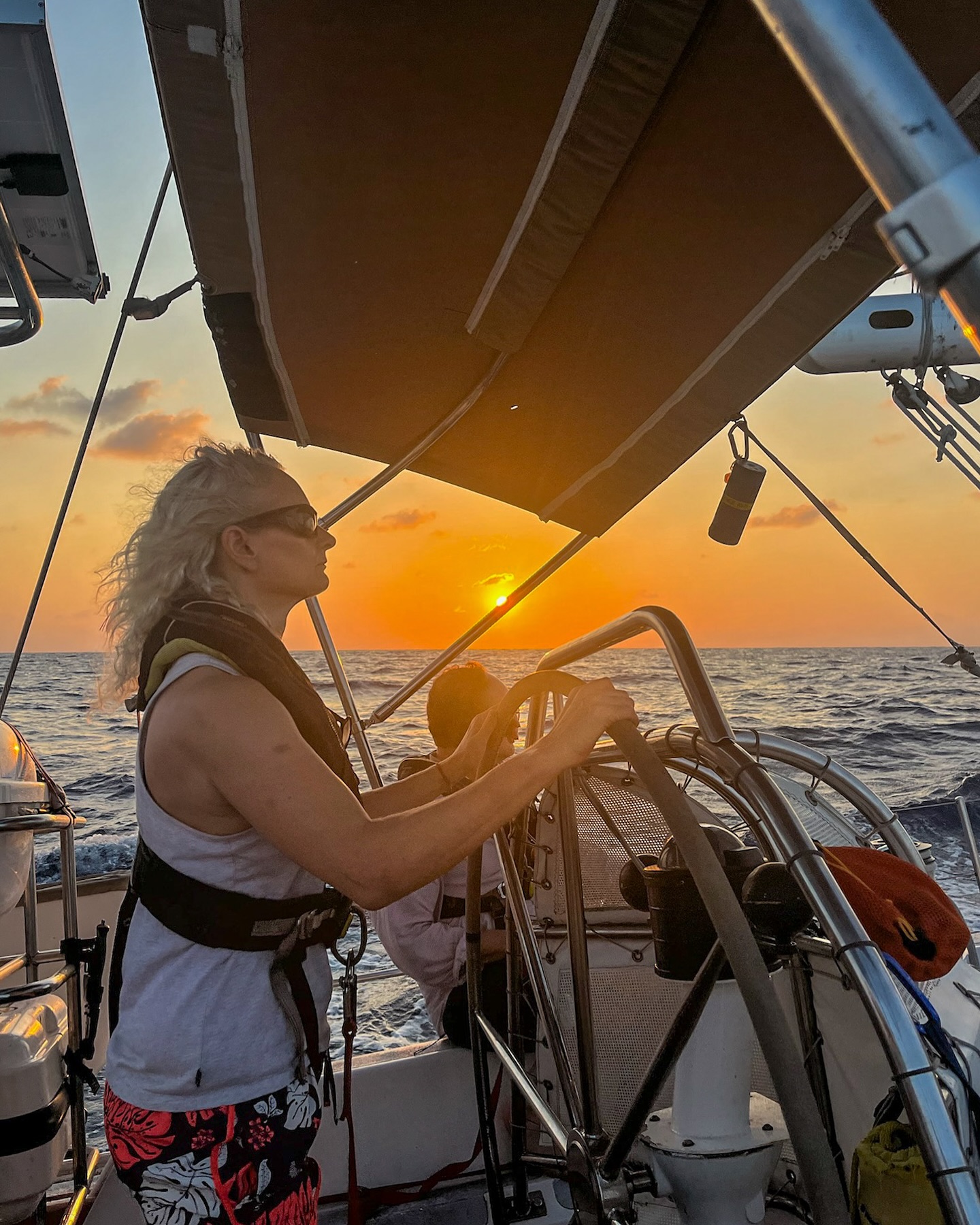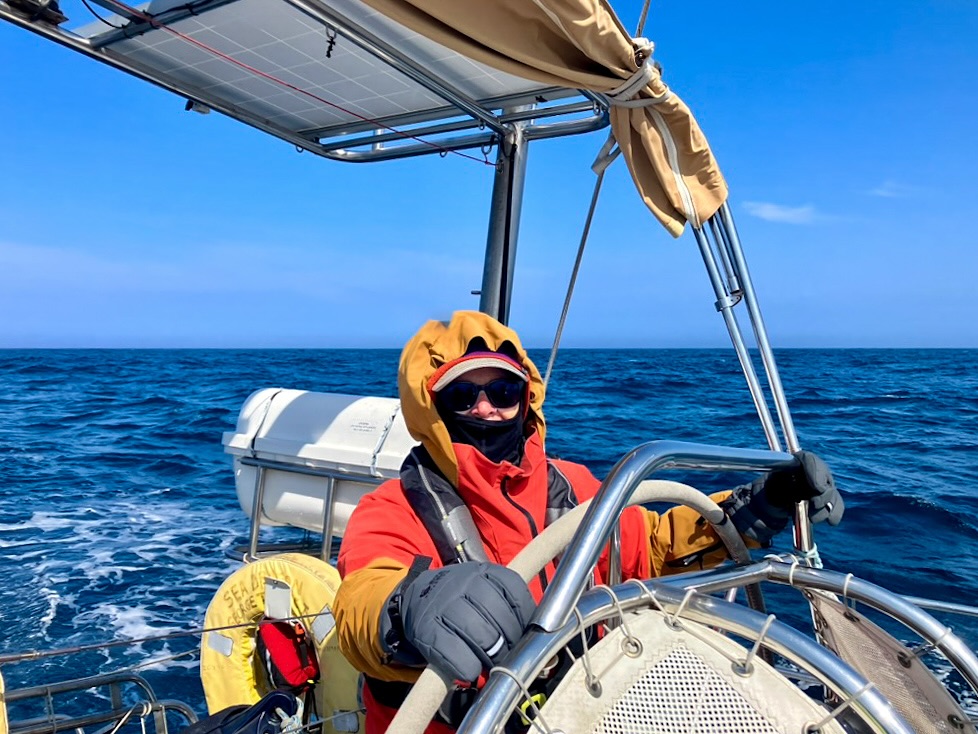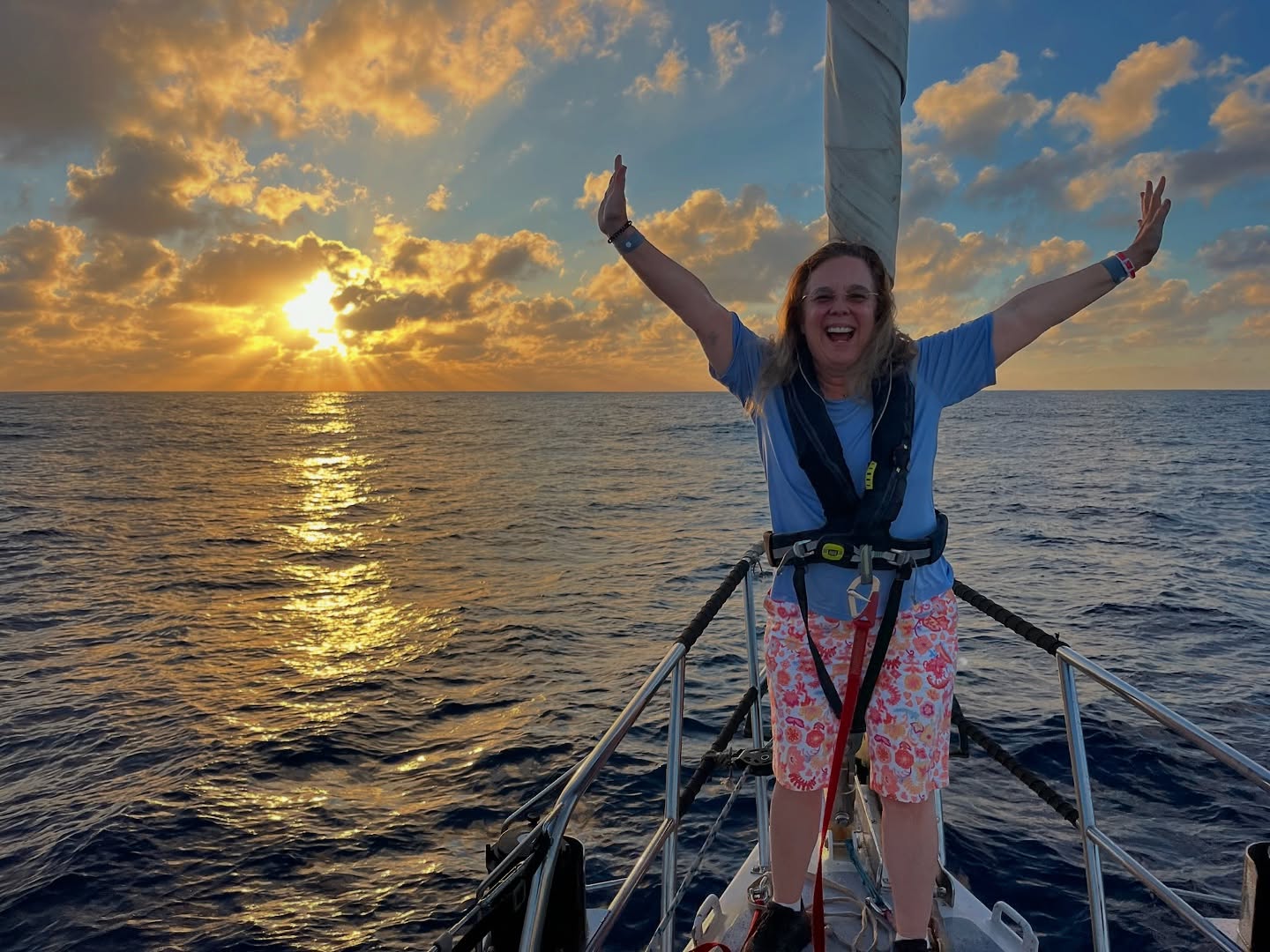Leaving Hawaii, Sea Dragon raised sail and headed south. Along with the jib and main, we also flew a staysail on the inner forestay. Good wind gave us about 8kts of boat speed for almost the entire way to Palmyra. As we got closer to the equator, nighttime squalls would blow through bringing rain and some gusty wind. Everything got, and remained, slightly damp. The sails were raised and lowered, furled and unfurled, and reefed and unreefed (dereefed?) depending on how dark the squall looked—made a night watch a little more active than usual. One brought us a gust of 33.8kts! My highest sighted wind speed. That was pretty exciting.
In the five days it took to reach Palmyra, all 10 of us got well acquainted. Breakfast is whatever and whenever you desire (which could be 3am or 10 am, depending on your watch schedule), lunch is optional (if you’d rather try to nap), but dinner is the one time everyone on the boat meets on deck for a big meal. If we’re lucky, the clouds give us a beautiful backdrop and a gentle sunset.
Soon into the voyage, “boat brain” sets in and the conversations get…interesting. Any and every topic under the sun gets covered. The boat favorite was the mystery of the Palmyra murders in the early 70s. There were at least four of us reading Vincent Bugliosi’s book, And the Sea Will Tell, and a few podcasts going around. If you haven’t heard of the murders (or was it a single murder? Only one body was ever found…), I suggest you google them so you can weigh in with your own theories. My personal belief is that the two couples found the treasure of the Esperanza, a ship carrying gold and silver stolen from the Incas that was wrecked along the coral reef of Palmyra, and somewhere along the line a scuffle and a double-crossing ensued. But that’s pure conjecture.
The night before we reached Palmyra was the blackest black there is. The entire horizon, in every direction, was gone. No ocean, no sly, just a deep, inky blackness. Every now and then, lightening in the distance would brighten the sky in a cool blue light. The darkness was disorienting in the most intense way—you could feel the boat lifting on a swell or turning with a gust, but with nothing for reference there was no way to tell which way you were turning unless you stared at the compass. But the sun finally rose, the wind died, and we motored the rest of the way to Palmyra. A few miles out, a giant pod of bottlenose dolphins greeted us with chitters and joyful leaps across the waves.
We called the station on Palmyra as we neared the channel, and a skiff came out to guide us into the lagoon. All of us were on deck soaking in the sight of bright blue water and vibrant green trees. We saw our first black tipped reef shark on the way in! After getting situated, we all rode into shore and were met by the managers. Two entities run the station on Palmyra: The Nature Conservancy and Fish and Wildlife. There are around 15-20 people on the island at one time, and they rely on infrequent flights or barges for provisions. Most of their electricity comes from solar power, although they occasionally turn on the generators if it has been rainy for a few days—Palmyra gets an average of 14 inches of rain per month! Most squalls pass through pretty quickly, but they said a few days before we arrived they had gotten 5 inches of rain in ones day.
A brief Palmyra history: it was first sighted by Edmond Fanning, but he failed to record this before Captain Sawle, skipper of the Palmyra, sent an official dispatch with the islands coordinates. In 1862, Hawaii’s King Kamehameha IV gifted the island to two of his subjects, who spread coconut palms across the islands in an attempt to start a farm. It was later annexed along with Hawaii in 1898. From there, it was passed down or sold to various people until it reached the Fullard-Leo family in the 1920’s. In 1940, it was declared a defense area by the US government, and a Navy station was built on the island. The Fullard-Leo family went to court to say hey don’t build on our island, and won the case. The Navy quickly pulled out of the island, leaving behind an airstrip, ammunition bunkers, and abandoned buildings. The station currently on the island still uses the water catchment building that was erected during this time.
The scientists on the atoll are trying the encourage the return of the islands “natural” state, before the introduction of excessive palm trees, rats, feral cats, and mosquitoes. The rats (30,000 of them!!) were finally eradicated in 2011 along with the cats. This encouraged the resurgence of native species such as land and hermit crabs, three types of boobies, and sooty terns. The island is currently at hermit-crab-capacity, meaning just about every shell you can find has a crab in it! Which is pretty cool.
Currently, there is a rainforest rehabilitation project that is trying to control the coconut palm monoculture on the island. Naturally, coconuts wash up on the beaches of the atoll and palms will grow along the edge of the beach. But with human meddling, the palms were spread to the inner parts of the island, stealing sun and space from native flora such as Pisonia grandis trees. In addition to inhibiting the growth of native plants, palms are not good nesting trees for the birds of the island. In fact, they won’t even sit in them. It’s a slow eradication project that requires multiple cycles to catch the trees in their various states of maturity, but the hope is that with the return of the natural ground coverage, the bird population will return to pre-human levels.
One of the most amazing parts of Palmyra are the surrounding reefs. The dredging by the Navy in the 1940’s killed most of the coral within the lagoon, but once outside the channel entrance, the underwater landscape contains more than 150 varietals of coral and thousands of fish, as well as a healthy shark population and manta rays. This reef is very rarely fished and does not come into contact with the toxic run off created by human cities, making it one of the healthiest reefs in the world.
The first night, we were invited onshore for a delicious taco dinner and the company of a fresh group of faces. After dinner, there was an excursion to find scorpions on coconut crabs, some of which can live to be 60 years old! They also turned on a dock light and attracted three large manta rays. The rule is, you can’t touch the wildlife but you can let it touch you. We stood still in the water as the mantas made gentle circles around us, flicking the tips of their long, graceful wings along our thighs.
Over the next day and a half, we made two very exciting snorkel trips out to the south western tip of the reef, called Penguin Spit. I was a little nervous at first, as this was only my third snorkel ever, but everyone else’s excitement was catching and I flopped off the dinghy in my flippers. The ocean floor was the most exotic thing I have every seen in my life. So many different shapes and colors and textures and sizes! After a gurgled exclamation of wonder, I turned my head to see a black tipped reef shark, about 4 ft long, swimming among the coral heads. My snorkel buddy, Meret, grabbed my hand excitedly as we watched it slide through the water from a distance. I thought it would be scary to see a shark, even a relatively “safe” one such as a these are, but the movements were so graceful the beauty of such a powerful creature overwhelmed any feeling of worry. Plus, Meret was super excited so I figured there wasn’t a real threat.
Jessica captured this photo of a steelhead parrotfish nibbling on some coral! As amazing as it is, it barely does the reef justice. We also saw striped surgeonfish, moorish idols, blue spine unicorn fish, peacock groupers, and many, many more. Our second snorkel excursion we saw a gray shark as well as a few more black tipped ones. It was probably a good thing I had no idea grays are a bit more chompy than the black tips… Our last night in Palmyra, the island blessed us with a rainbow and a beautiful sunset. The next day, our new friends from the station sent us off with a blow from a conch. As we raised anchor and headed towards the channel, we returned the goodbye with a chorus of our best conch-horn impressions.
Sea Dragon has just arrived at Christmas Island, and her crew are looking forward to showers and cold beverages. Yet another amazing passage is coming to a close, and although sad to be parting with such a wonderful crew, the memories we all have are as bright and beautiful as the reality that made them.

























